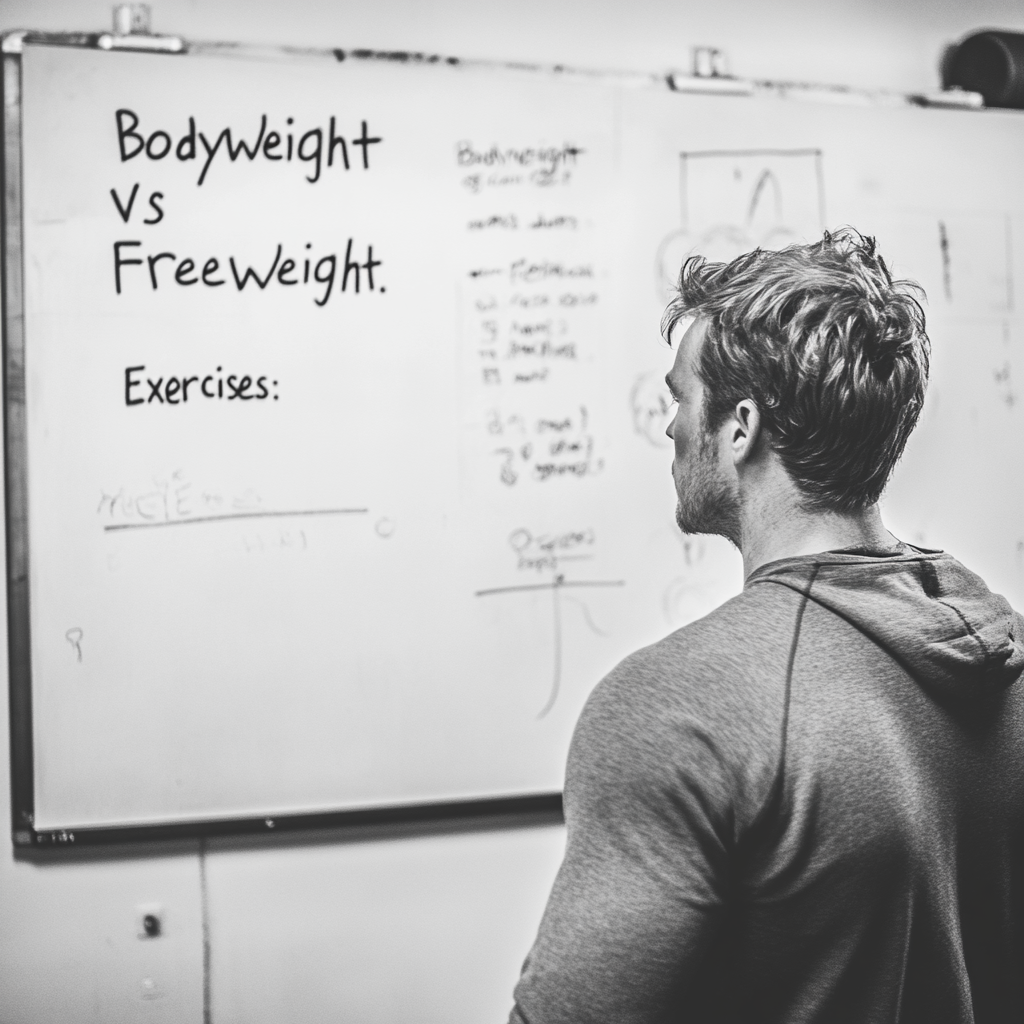Introduction
For as long as people have started resistance training, this question has loomed: bodyweight or free weights? This is a tricky question which has confused the fitness enthusiasts as well.
The abundance of options range from weight lifting work-outs at the gym to bodyweight exercises at home. 68% of gym-goers in a recent study said they used both.
But which one is king when it comes to building strength? Today, we will discuss both of these types of exercise training. Then, you can choose which form of resistance training helps you build strength best.
Understanding the Basics of Bodyweight and Free Weights Workouts
Before we name a winner of the bodyweight vs free weights battle, let’s break each one down.
Bodyweight Exercises

Bodyweight exercises call for using your own body mass as resistance. You don’t need any gym equipment to do these movements. You can change them in many ways, making them very versatile.
Bodyweight exercises like pushups, pulls-up, squats and planks are some of the most conventional ways to build muscle without weights. These exercises typically concentrate on practical strength, increasing body control and lean muscle endurance.
Calisthenics is a great bodyweight fitness routine. It includes exercises like muscle-ups and handstands. These exercises test your strength and balance.
Free Weights
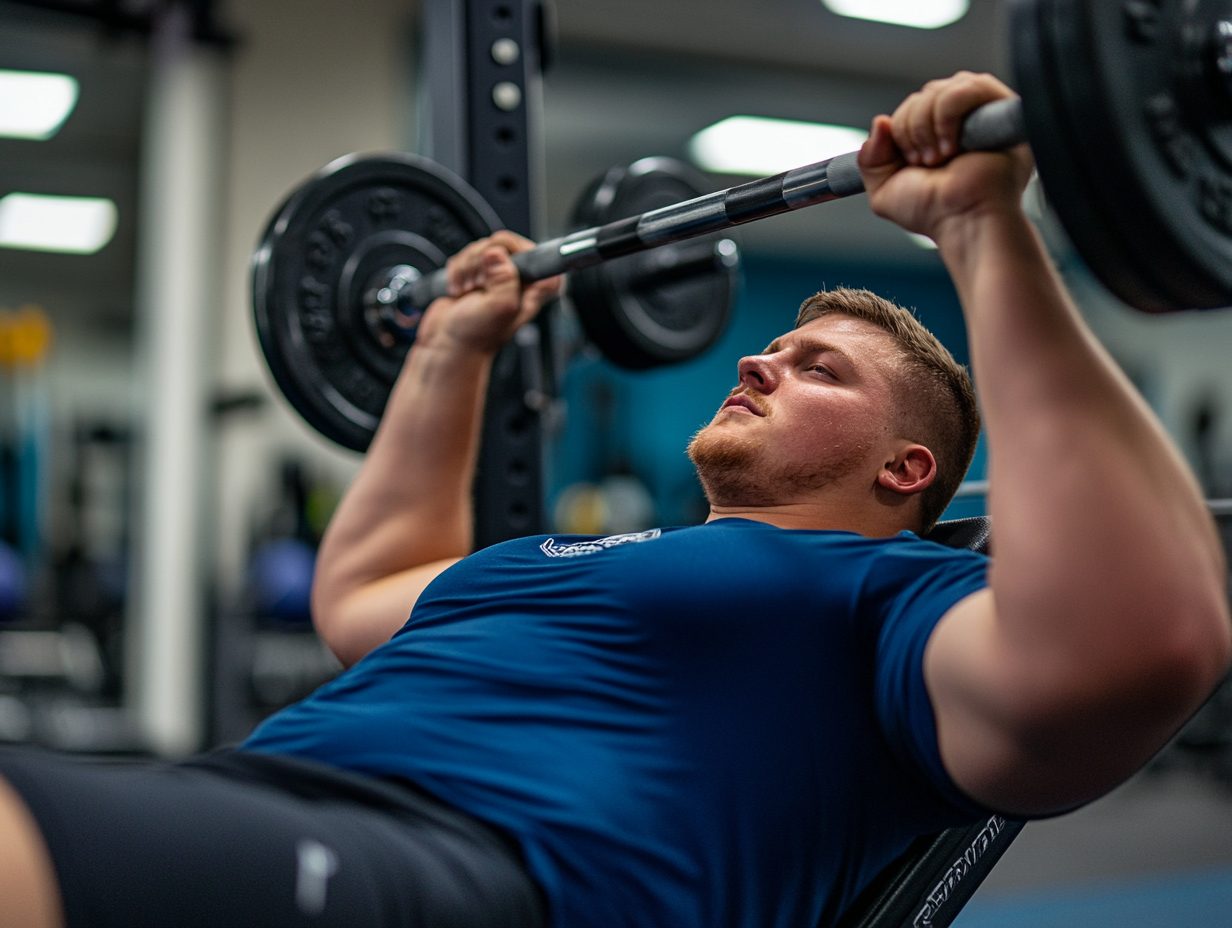
Free weights are pieces of equipment that aren’t attached to any machine, which in turn lets you do a full range of motion. These types of workout equipment can include dumbbells, barbells, kettlebells and even resistance bands. Common free weight exercises include the bench press, deadlift, and bicep curls.
My favorite part of free weights are that they are perfect for isolating muscle groups, creating the stretching between the muscles that is essential in hypertrophy, and providing the opportunity for progressive overload, which is integral to growing muscles.
Pros and Cons of Bodyweight Exercises
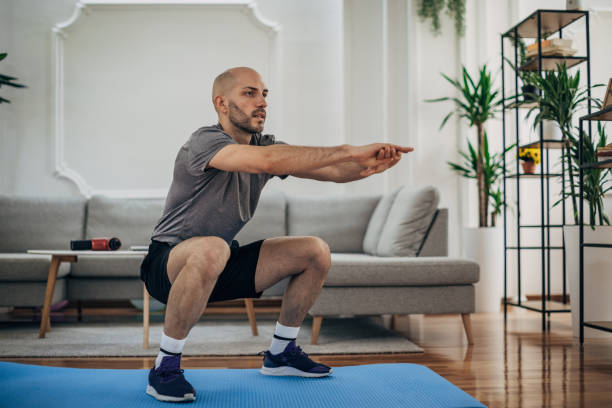
Pros Of Body Weight Workouts
Cheap!
There are several advantages to bodyweight exercises. For one, they are cheaper. You can get started right out of the gate without requiring costly gym equipment.
Functional Strength
They also help in building functional strength which helps to increase your overall balance, core stability and also will improve the ratio of strength-weight.
Whole Body Workouts
Bodyweight workouts offer an overall body workout as they activate various muscle groups all together. This makes them great for increasing muscle endurance and general fitness.
Downsides to Bodyweight Training

Even though we’ve established that bodyweight training works well for both lower-body and upper-body strength, it does have its limitations.
No Progressive Overload
One of the biggest problems is that it’s hard to get in progressive overload. It can be hard to keep increasing load as you progress with basic movements like push-ups or squats. This is because you cannot add more resistance when using your own body. This can impair muscle hypertrophy and strength development.
Limitations of Muscle Groups
Moreover, some muscles may be harder to train with bodyweight exercises alone – such as the biceps or the lower back. So there are only so many options.
Who Can Benefit From Bodyweight Movements The Most?
Bodyweight training is great for beginners, people who may have limited access to various pieces of gym equipment or even just someone wanting and needing more functional everyday fitness. It’s also a great place to start for those looking to build confidence before going in an intimidating gym.
I know that when I started working out, doing push-ups and pull-ups were a great place for me to start and build some strength and confidence before getting in the gym and trying to lift heavily.
It’s also a great way to get workouts in for those that would rather stick to at-home workouts or train outside more.
Pros and Cons of Free Weights

Pros of Training with Free Weights Include:
They Are A Natural Strength Builder
Free weights are amazing for building strength and muscle in a way that bodyweight exercises may not be able to.
Allow for Compound Exercises
A major advantage is that they allow for compound exercises such as squats, deadlifts and bench presses, which involve movement at multiple joints. This both increases strength substantially, but also hypertrophy.
Precision in Resistance
In addition, free weights provide more flexibility in training – you can calculate resistance by the pound, which plays an important role when we need progressive overload.
Variety in Routines
These exercises also allow you to make a program with a variety of exercises, allowing for greater muscle isolation and workout variation.
Potential Risks and Things to Keep in Mind:

With that said, free weight training does come with some cons.
Higher Injury Risk
Lifting weights incorrectly or using improper form can be a factor in injuries as well. Proper form is essential, and can be taught by an experienced trainer if necessary to avoid the downfalls. There’s a lot higher risk of injury when using added resistance.
Not Easy to Do at Home
Even if you could afford dumbbells or barbell gym equipment, they take up a lot of space at home for all the weights.
Who is Free Weight Training Ideal For?
Free weight training can be ideal for someone trying to maximize muscle gain, and trying to get every ounce of strength they can!
Athletes, including those working on sport-specific training, can benefit as well. Free weights can replicate many natural movements associated with different sports
Bodyweight vs Free Weights: Muscle Activation and Growth

Muscle Recruitment Across Both Methods
The muscle activation of bodyweight and free weight exercises differ. Bodyweight exercises not only activate the stabilizing muscles, but also train you to improve coordination among all of your muscle groups. For example, a push-up, in addition to the chest and triceps, also works hard to engage the core so you maintain balance right.
Although, with free weights you can target single muscles and maximize the activation and growth of that particular group. For example, a bicep curl will directly target the biceps so in this case the muscle hypertrophy of that muscle group can be isolated. It’s more focused.
Progressive Overload – How Each Addresses It
Progressive overload is almost necessary for constant muscle growth. Free weights can be easily made harder by upping the sets, reps, and weight lifted in increments.
Meanwhile, bodyweight exercises require a lot of problem solving in terms of making things harder as you get further along. For example, you can try using varying tempos, altering leverage, or added resistance (like weight vests) to assist you in maintaining progressive overload when bodyweight training.
Impact on Hypertrophy and Strength Gains
Despite those benefits, free weights will generally win out in the long term over bands if hypertrophy or strength gains are what you’re after due to how easy it is to increase resistance (progression). Even so, bodyweight exercises can yield great strength improvement in functional/ endurance strength.
Practical Things to Consider

Initial Investment and Long-Term Costs
Going off the financial aspect first, bodyweight exercises are as high a winner you can get. First, they come with no financial obligation to acquire them, and free weights can get expensive quickly if you are building a home gym. Paying for a home gym is probably only worth it for the serious lifters who want to make long-term strength gains at home.
Space Considerations
Bodyweight exercises need minimal space, as they can be done within a small room, studio or an outside area. Opposite this are free weights and in particular barbells, and weight plates – these can be bulky and require more space. Once again, bodyweight takes the cake here.
Accessibility and Convenience
The ultimate convenience comes from bodyweight training. You can work out literally anywhere at any time without requiring access to a gym. While free weights work well, they do require a gym membership or home setup which many people may not have access to. 3/3 for body weight in this section.
Hybrid Approach to Combine Both Worlds
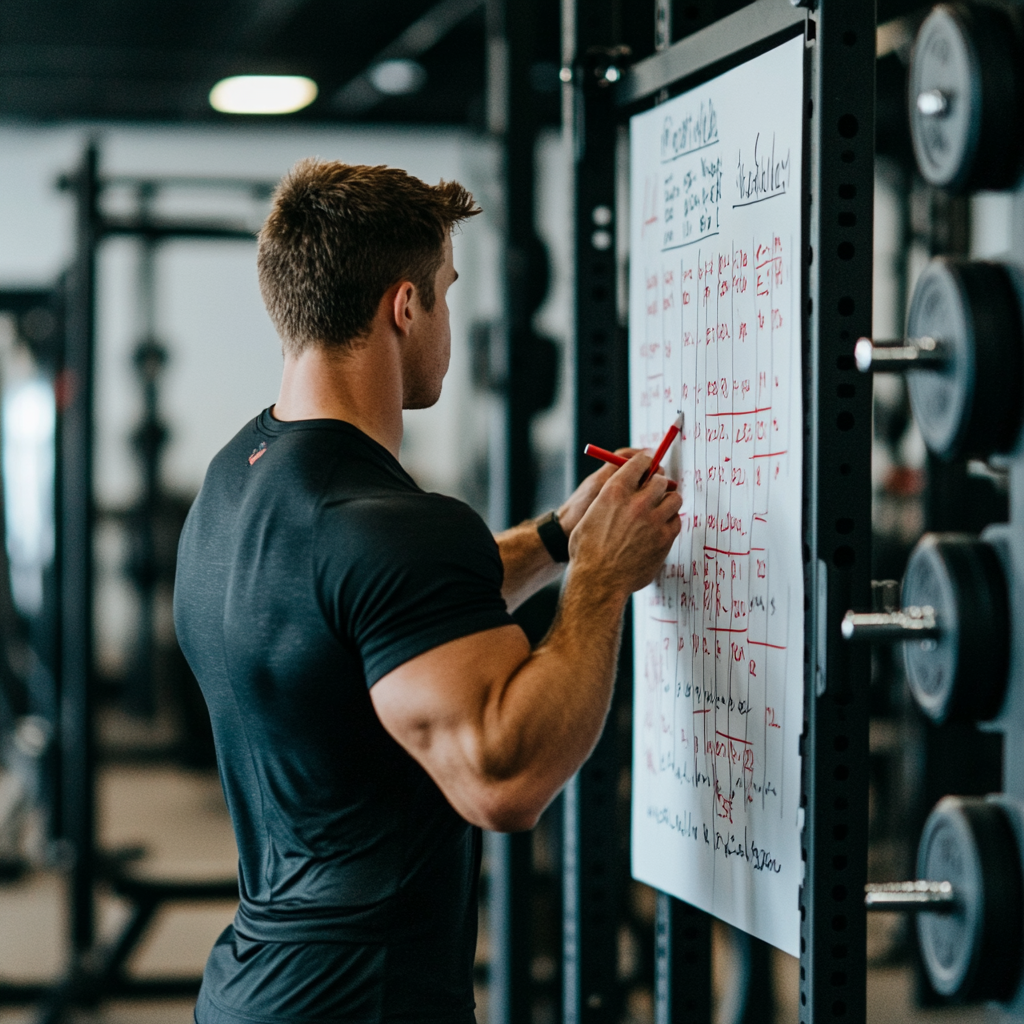
Benefits of Incorporating Both Methods
For people that want the benefits of both a hybrid approach using bodyweight and free weights may be beneficial. This is a perfect middle ground of functional strength, hypertrophy and overall fitness.
You can include push-ups and pull-ups along with a dumbbell exercise to get a comprehensive workout that works on more than one muscle.
Sample Workout Routines Using Bodyweight and Free Weights
- Upper Body Day: Start with bodyweight push-ups and pull-ups, then move to dumbbell bench presses and bicep curls.
- Lower Body Day: Begin with bodyweight squats and lunges, then transition to barbell deadlifts and kettlebell swings.
- Core and Balance Day: Incorporate planks and mountain climbers with exercises like dumbbell side bends and kettlebell Turkish get-ups.
How to Keep a Good Balance Between both For Best Results
If you want the best results, then it is important to use what suits your fitness goals. For instance, if your goal is to gain mass then prioritize free weight exercises with higher resistances.
If you are training for increased functional strength and stamina, consider switching to bodyweight exercises with higher repetitions.
Selecting Based on Your Fitness Goals

Strength Vs Endurance: Which Training Comes Out On Top?
Free weights are the best for optimal strength gains and muscle hypertrophy, while bodyweight exercises are better used to develop muscular endurance and functional strength. That is up to you, it should simply come back to your future health goals. Just think, strength/mass=free weights, endurance/functional strength=bodyweight.
Sport-Specific Training Considerations
Both methods have benefits for athletes. For example, a football player might take advantage of free weights for max power and size, but also use bodyweight routines to develop agility, stability and explosiveness. Both are useful here, depending on what you need more in your sport.
Adapting Your Approach Based on Experience Level
Beginners may have an easier time with bodyweight training because they help you in building up strength and technique in those movements. They are also easy and convenient to do, which is perfect for beginners.
When you become an advanced lifter, leaning on free weights will be a greater challenge, allowing you to push limits even further. But, this is where pushing yourself harder through increased ranges of motion with heavy weights can also start causing damage if not careful… So always remember that the goal should always be to use proper form for any exercise!
My Experience with Bodyweight and Free Weight Exercises
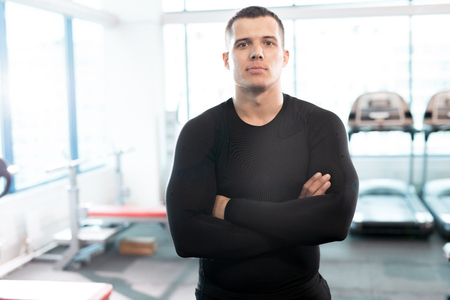
In terms of bodyweight exercises, I love them for what they are. I remember when I was living in Europe, often without a gym to go to, and I could do whole body workouts without any weights. It was great. I broke out in a full sweat and felt like I had actually gotten a great workout in, without any gym needed.
I also do think that push-ups, pull-ups, and dips, are among the most important exercises that exist, and in order to build true functional strength, you should give them a try.
That being said, free weight exercises are where I have truly made a significant difference in strength and muscle size.
With free weights I am able to focus on muscle groups and really tear up those muscle fibers. For example, with the legs, it is difficult to gain size and strength doing just bodyweight squats. Load on a couple plates to a barbell and squat a few times, and you will gain that in no time.
I also just love the feeling of trying heavier weights for exercises than I did last time I did that exercise. There is something about the feeling of progress with free weights that I love.
Both types are amazing for what they do for you. So I often do both throughout any given workout, and would recommend the same to anyone.
If you want to build size and strength, go with free weights. If you want to build functional strength, have that lean muscular look and maybe even lose weight, bodyweight exercises may be for you. It all comes down to what you are looking to get out of your workouts.
Conclusion

There you have it, fitness enthusiasts. We’ve explored the pros and cons of bodyweight vs free weights, and you all got the definitive answer you were looking for….it depends!
I know, I’m sorry, but you have to understand that each method has its advantages and both are capable of building tremendous strength. So really you should try both!
The important thing is to pick the way that you feel works best for your goals, lifestyle or preferences.
Remember, the best workout is the one you will stick with. So it truly does not matter if you are in Team Bodyweight, Team Free Weights or the Hybrid Squad, as long as those fitness goals are getting crushed!
Now take this information, carry on, and make some gains — your stronger selves of the future will appreciate it!
Sources:
- Ogawa M, Hashimoto Y, Mochizuki Y, Inoguchi T, Kouzuma A, Deguchi M, Saito M, Homma H, Kikuchi N, Okamoto T. Effects of free weight and body mass-based resistance training on thigh muscle size, strength and intramuscular fat in healthy young and middle-aged individuals. Exp Physiol. 2023 Jul;108(7):975-985. doi: 10.1113/EP090655. Epub 2023 May 3. PMID: 37133323; PMCID: PMC10988481.
- Haugen ME, Vårvik FT, Larsen S, Haugen AS, van den Tillaar R, Bjørnsen T. Effect of free-weight vs. machine-based strength training on maximal strength, hypertrophy and jump performance – a systematic review and meta-analysis. BMC Sports Sci Med Rehabil. 2023 Aug 15;15(1):103. doi: 10.1186/s13102-023-00713-4. PMID: 37582807; PMCID: PMC10426227.

